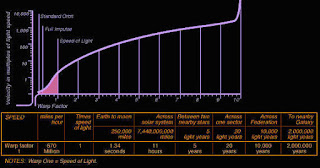 |
| Image Source: Pics About Space |
Topics: Einstein, FTL, General Relativity, Star Trek
For the record: \\//_. Now that my "Trek creds" have been established...
Gedanken is a German word for "thought." It is often colloquially defined along with the word experiment, which is where a lot of the notions of Special and General Relativity took place in Einstein's mind; his innate ability to conceptualize a tough idea.
It is also by definition, an experiment that is impractical to carry out. Part of it being impractical is the incredible energies that would be needed to propel a star ship to even 0.10 c, or in Trek parlance: "impulse." An aircraft carrier is ~64,000 metric tons (I'm using it as my "Enterprise," which is supposed to be pretty big). That's 64,000,000 kilograms. Simply multiply it by 0.10 x 3.0 x 108 m/s2 this will give you the energy output in Joules: 1.92 x 1015. The PLANET in 2013 generated 5.67 x 1020 Joules.
Part of the constant research is that sometimes what you're looking for may not be found, but the techniques you use in any analysis may have an application in areas you may not have imagined. As such, it becomes a part of the research one can reference and build on, thereby increasing the overall knowledge of a subject area.
Abstract
Warp drives are very interesting configurations in general relativity: At least theoretically, they provide a way to travel at superluminal speeds, albeit at the cost of requiring exotic matter to exist as solutions of Einstein’s equations. However, even if one succeeded in providing the necessary exotic matter to build them, it would still be necessary to check whether they would survive to the switching on of quantum effects. Semiclassical corrections to warp-drive geometries have been analyzed only for eternal warp-drive bubbles traveling at fixed superluminal speeds. Here, we investigate the more realistic case in which a superluminal warp drive is created out of an initially flat spacetime. First of all we analyze the causal structure of eternal and dynamical warp-drive spacetimes. Then we pass to the analysis of the renormalized stress-energy tensor (RSET) of a quantum field in these geometries. While the behavior of the RSET in these geometries has close similarities to that in the geometries associated with gravitational collapse, it shows dramatic differences too. On one side, an observer located at the center of a superluminal warp-drive bubble would generically experience a thermal flux of Hawking particles. On the other side, such Hawking flux will be generically extremely high if the exotic matter supporting the warp drive has its origin in a quantum field satisfying some form of quantum inequalities. Most of all, we find that the RSET will exponentially grow in time close to, and on, the front wall of the superluminal bubble. Consequently, one is led to conclude that the warp-drive geometries are unstable against semiclassical backreaction.
Physics arXiv: Semiclassical instability of dynamical warp drives
Stefano Finazzi,1,∗ Stefano Liberati,1,† and Carlos Barcelo2
Comments